 By Dietitian Jill Place
By Dietitian Jill Place
This is my most POPULAR post … and I don’t know why. Because I DO believe that a salicylate sensitivity is a symptom of a bigger problem … most likely a leaky gut. So I’m deconstructing the low salicylate diet here …
Along with my reasons, being The Good Gut Queen (ahem), for being iffy about its use. But so many people ask me about it daily that I just HAD to put my two-cents into a freebie. Obviously I’m torn … here’s why …
I’m not a HUGE advocate of restrictive diets, especially the Low Salicylate Diet. I do, however, put people on them for various conditions as past experience has shown that they help tremendously.
But I’m extremely leery of many of them for tons of reasons. Some of them being that …
Food has Many Naturally-Occurring Compounds …
… and the most common ones that clients ask about are histamine, salicylates, benzoates and oxalates. As a matter of fact, [click_to_tweet tweet=”I must get inquiries daily about salicylates … I just got one this morning.” quote=”I must get inquiries daily about salicylates … I just got one this morning.” theme=”style2″]
But there must be excellent research (or thousands of anecdotal case studies) about these compounds before I would even consider putting people on a diet to counteract them.
For example, there’s tons about gluten sensitivity. As a matter of fact, a 2016 study by researchers from Columbia University all but proved that any gluten consumption rips up the gut … even in healthy individuals.
That’s why I wrote the book, Gluten-Free in 5 Days. I went gluten-free five years ago and have nothing but good things to say about it. And after reading that study, I now believe that going gluten-free might benefit everyone! But …
[click_to_tweet tweet=”there isn’t great research that restricting any of the natural compounds above, including salicylates, really helps. ” quote=”there isn’t great research that restricting any of the natural compounds above, including salicylates, really helps. ” theme=”style2″]
Also, restrictive diets can be problematic for many other reasons. One being …
There are Varying Degrees of Compounds in Foods
That’s why it’s very hard to make definitive categories for them. The level of gluten in foods doesn’t vary much. But when I did the graphics for the Low Salicylate Diet below, I consulted many lists … all disagreed. So these are the best guesses I could figure out … but at best they’re only guesses.
Case in point … apples. Different types appear on the “Fruit” list in varied positions. But several factors may confound the level of salicylate in them besides types … including growing conditions and transportation. In other words, the occasional apple may have higher levels. Not only that …
Also, these lists are all formulated using 100 grams (about 3 1/2 ounces) of each food. So the ones where you don’t use a ton … like coffee, tea, or spices (many of which as no-nos) … are at a disadvantage here. But I’m MOST concerned that …
These Diets Don’t Address the Client Factor
I once had a client who mourned eggs for two months. As a practitioner, I’m very sensitive to what clients will or won’t do. You can give a client the best diet or best supplements in the world but they won’t be effective unless they do or take them.
And, if they actually do the suggested diet, clients may get frustrated, confused, and start restricting more foods as they start obsessing about what and what not to eat. The result is that they’re always playing what I call “diet-catch-up” … trying to figure out what other foods don’t work for them. And restricting even more until there’s literally nothing left to eat.
As a matter of fact, the person who contacted me this morning had tried the Low Histamine Diet and was now moving on to addressing salicylates because … in her own words … “it appears that salicylates are also playing a role in my symptoms which are getting worse”.
Since there’s no definitive test for salicylate sensitivity, and even the salicylate threshold on the food sensitivity testing I do is two aspirin … a honkin’ lot of salicylate … how does she know that? What people are doing in this “diet catch-up” whirlwind is …
Forgetting that There’s a Root Cause for this Problem
There’s a core reason that you feel lousy. I always say that “Health starts in the Gut”. And, since 80% of us have leaky gut, a condition where toxic stuff gets into the bloodstream that shouldn’t be there, our body’s reactions to this “stuff” can have different manifestations.
In other words, if you’re genetically predisposed to a foot problem, you’ll get a problem with your feet. Or your skin. Or your thyroid. Or … you name it. Good Guts make GREAT lives.
So Now Let’s Talk about Salicylates
Our bodies are really wise. They’ve developed mechanisms to extract needed nutrition from food and clear away those other elements that aren’t needed or wanted. They clear away the salicylates (and the other compounds I talked about earlier) in food by detoxifying them.
There are enzymes we make that do this. And if we have those enzymes, it means that our bodies are meant to handle these compounds in positive ways.
But a deficiency in these enzymes, which many people think is the root cause of these sensitivities, is RARE. Much more common is an overload caused by the inability of your gut and liver to detoxify the flood of toxins from many sources. Including natural compounds like salicylates.
Our bodies weren’t built to take care of the overload of these cumulative toxins. As a result, [click_to_tweet tweet=”allergic-style inflammatory reactions occur not as a result of the compound, but as a systemic response to a general overload.” quote=”allergic-style inflammatory reactions occur not as a result of the compound, but as a systemic response to a general overload.” theme=”style2″]
So Why the Low Salicylate Diet?
Well … as I said … I’m not a huge believer in restrictive diets. But I DO believe in giving them a try to find out if there’s a deeper problem that needs to be explored. Here’s the entire Ebook …
<
So … after looking at much information about this diet, here are my recommendations … my advice … stick to the foods in the orange sections and avoid the ones in the green sections. And stay tuned afterwards for advice about how to make a restrictive diet work in your life …
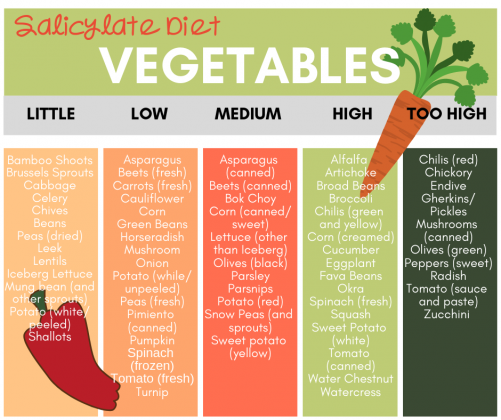
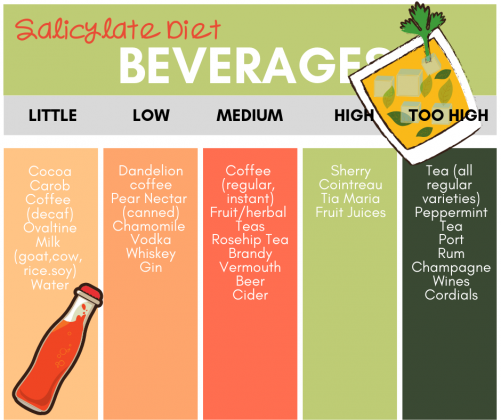
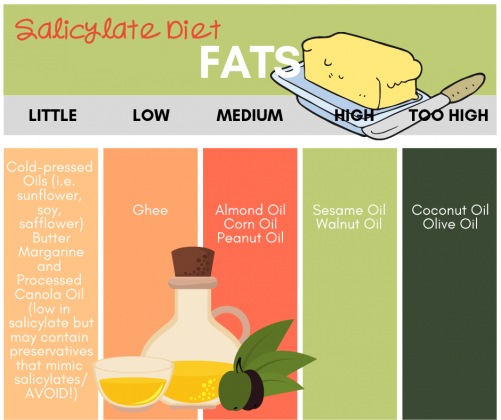
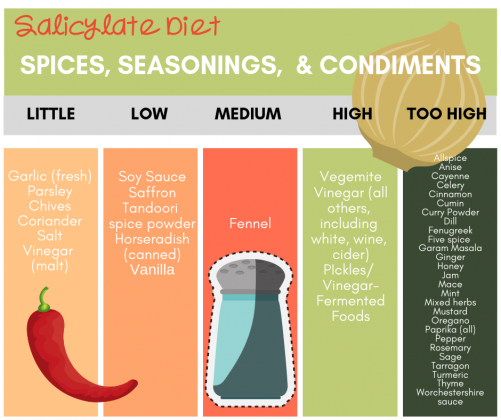
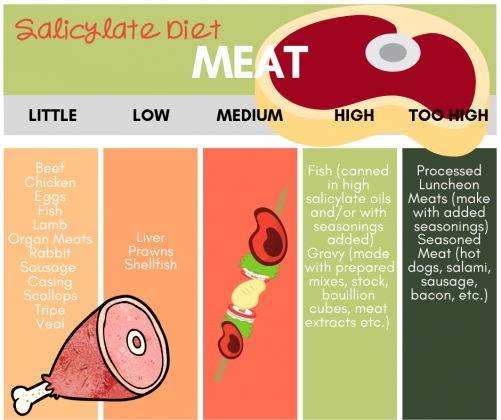
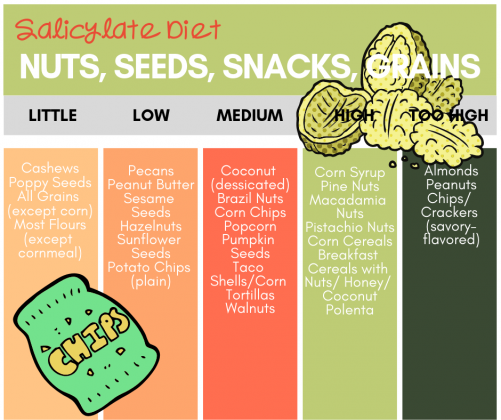
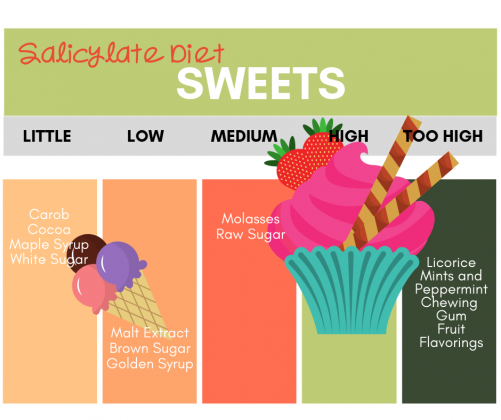
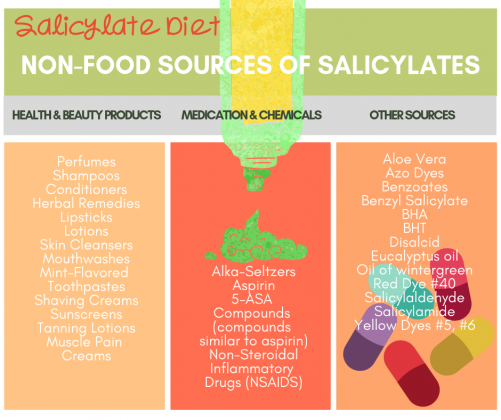
Some Tips for Making Restrictive Diets Work for You
So if … after my much finger-wagging in this article … you’re still determined to try a Low Salicylate Diet … consider these …
Use the list as a guideline. Don’t go crazy checking out every similar diet. Pick this one (or another) and start with that.
Find the best diet for you. No list fits perfectly. Experiment and find out which one works for you alone.
Give yourself a time limit and stop if it’s not helping. Follow whatever diet you choose closely for a time … like two weeks. At the end of that time, ask yourself if it’s helped. If you’re not sure, it probably hasn’t made enough difference to continue.
Try one diet (or other treatment) at a time. I always start treatment with the appropriate diet while I’m waiting for test results. And then I recommend supplements, which I suggest beginning one at a time too. That way, I can figure out what does (or doesn’t) work.
Experiment further to find personal food tolerances. Everyone responds to foods differently. Therefore, you may be able to tolerate lots of popcorn (medium salicylates) but can’t eat cashews at all (negligible salicylates). If you’re not sure which food is a problem, begin with the first column the first week and keep adding food in the “low” and “medium” columns once a day to see if any are reactive.
Consult an alternative practitioner for your root causes. Even if the diet above works for you, [click_to_tweet tweet=”feeling lousy has a root cause. Find out what it really is by going to an alternative/functional medicine practitioner. ” quote=”feeling lousy has a root cause. Find out what it really is by going to an alternative/functional medicine practitioner. ” theme=”style2″]Many like me are virtual and worldwide.
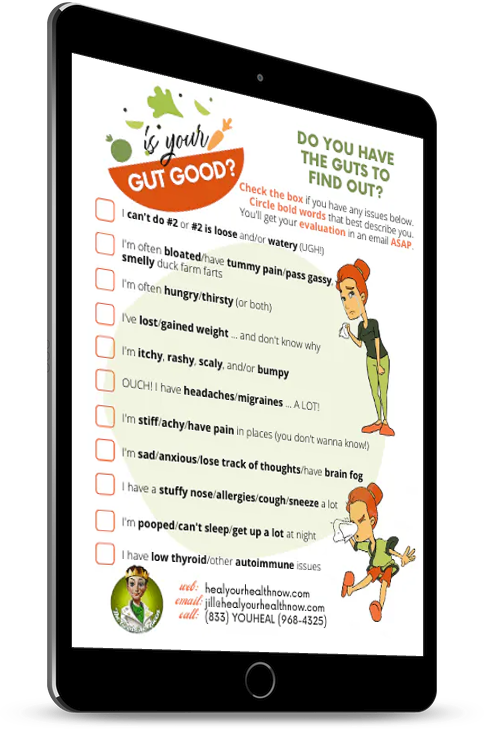
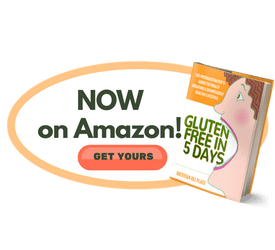
Hi Jill, Thank you for such a well balanced and informative article. I agree with you that different foods can affect one person and not another. I am under a dietician who started me on the Low FODMAP diet, but I noticed that some of the foods that I was able to eat actually made my eczema rash and body very itchy. So, after reading other health articles online, I began to wonder if some of my problems were to do with salicylates. It seems that many high salicylate foods and high FODMAP overlap. I’m slowly coming to see that many of them are causing my eczema to flare. However, one particular herb that I have no problem with is mint which is high in both diets. In fact, this herb, which I have in small doses helps my gut to be soothed. Like you said, everyone responds differently to different foods.
Diane … thank you sooo much for your comment. As I’ve said over and over in the article everyone is different with different sensitivities.
Also, trying to figure this all out by yourself is crazy-making and frustrating … and usually makes you worse in the long run. And may entail more than just doing a diet. That’s why you need a professional to figure this all out for you.
It’s really difficult to know which foods you’re sensitive to without running a food sensitivity test. I’m most interested in finding the root cause of what ails you instead of just stabbing in the dark with different foods.
And a lot of the time eczema can be healed by avoiding these sensitive foods. I’d love to talk with you about all this. Why don’t you email me … jill@healyourhealthnow.com. Or call 833-YOUHEAL and leave a message with your phone and a good time to call you at extension 1.
I’m having a tough time finding a nutritionist in my area that is educated on salicylates. I live in northwest Iowa. Any suggestions would be appreciated! Thank you!
Jacki
I work virtually … and YES … I understand salicylates but also understand that a manifestation of this problem means there’s a deeper cause. Would be glad to discuss this … please book a “Let’s Talk HEALTH” session … healyourhealthnow.com/letstalkHEALTH with me to explore this.
I was diagnosed with AERD 3 years ago. Been suffering for over 25 years. I’ve recently been put on Dupixent which has changed my life. I can actually breathe out of my nose and I’m not reacting to many different types of food and drink. Im wondering if this diet would help my ears. They feel clogged most days and I find it difficult to hear clearly. I see everything on these charts that are not good to eat are part of my diet daily. Should I do a 100% do over with my diet. And just eat the foods on this chart? Any help you can give me is appreciated! Thank you.
Karen … absolutely NOT. And I’m glad that you found a partial solution. I know you’ve been hurting a long time. But I think I have a better solution. My FOODStrong plan. Want to check it out? Go to healyourhealthnow.com/FOODStrong. Or you may want to check out my Let’s Talk HEALTH to guide you toward some next-step clarity. Here’s the link … healyourhealthnow.com/LetsTalkHEALTH I can sense that you want to be totally healed. And want to figure out next steps. Looking forward …
Hi Jill,
I have had stomach issues most of my life. I have Celiac, several skin issues, GERD, and recently found high amount of Mast cells in my GI track. I was found to be allergic to asprin when I was young. Baby asprin made me vomit and Pepto bismo broke me out in hives. I have avoided any meds or products that contained salicylate. I never thought to look at the food I was eating. Would it be beneficial to test for an asprin allergy again to see how strong my reaction is? I would do under a doctor’s supervision. I have an ENT and gastrointestinal Dr. I am so lost trying to figure out my stomach issues. I’ve tried and AIP, and it was recommended to do a low histamine diet. I am just tired of trying everything and nothing is doing better. I know trying and eliminating is part of the process but I’ve tried so much and nothing seems to work. Thank you.
Nicholle call me … 833YOUHEAL … WE NEED TO TALK!
Thank you for this! Do you have a fruit list of low to high salicylate fruits? Thanks!
Wendy Thanks so much for reaching out! I have that list in the Ebook that gives you alot of good stuff for transitioning to a low salicylate diet. I’d suggest that you go back to the post, scroll down to the bottom, and opt in for that. Here’s the URL https://www.healyourhealthnow.com/lowsalicylatediet/
Hi Jill,
Your lists look a lot like the RPAH elimination diet, but I noticed cocoa is in the ‘low’ section here, where it is in the ‘very high’ group there.. can you comment ?
Me again,
Sorry, I noticed this list is focussed on salicylates only and cocoa is only high in amines.
Thank you for a very nuanced review on this topic
Yes, Sofie … only focused on salicylates. Actually, I’m not a huge fan of these general diets anyway. But a HUGE fan of LEAP Mediator Release Testing, which isolates sensitive foods for you once and for all. And Root Cause Medicine, which treats whatever dysfunction you obviously have before it becomes full-blown disease. Are you open to talk about it? Please feel free to contact me at jill@healyourhealthnow.com or call 833YOUHEAL ext. 1. Thanks
What about fruits?
What about them? You have to download the ebook to see that …
People who are sensitive to salicylates are also very very often allergic to sodium benzoate and other benzoates. Most sunscreens and perfumes contain this. So, although you don’t see the word salicylate on the ingredients list, you should beware of any benzoates.
OK … If you read the last of this series … https://www.healyourhealthnow.com/beyond-salicylate-sensitivity/ and the article it cites. I find salicylate sensitivity to be only a symptom of a deeper problem as I’m concerned with root cause, which is mostly likely inflammation or leaky gut. I have clients that have everything from Hashimoto’s to Hidradenitis Suppurativa … they manifest differently but they mostly have the same root cause. I think that might be a consideration for you.
Hi there
I am highly allergic to Aspirin (I am talking take-me-to-the-ER-allergic) but I can tolerate natural salicylates (in food) in moderation. I am allergic to benzoates (the two go hand-in-hand) and I just want to remind everyone that salicylates and benzoates like benzyl alcohol or benzoic acid also occur in personal products like shampoo, mousse, make-up, perfumes, deodorants, sunscreens and lotions. If you eat low salicylate but your personal products contain salicylates or benzoates, you will still get negative symptoms. (I get hives and I itch like hell.) Taking antihistamines help me and also taking a bath with a hand full of Epsom salt in the bath. The magnesium helps to neutralise the salicylates.
I agree Christel … and I’ve listed them in my ebook. Questions … have you ALWAYS been allergic to aspirin?